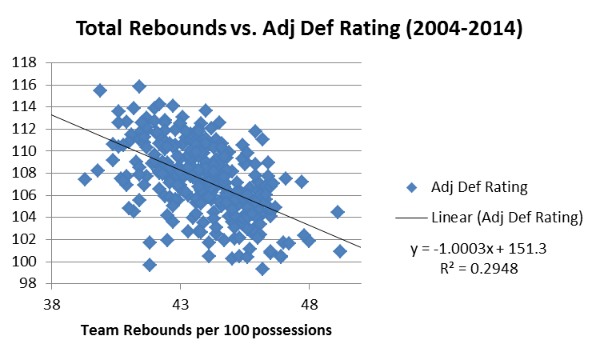The Correlation Between Team Stats and Offensive and Defensive Efficiency, Part 4: Rebounds

Today we’re continuing our series of looking at pace-adjusted team stats in relation to team offensive and defensive efficiency. There are six parts of this series; we’ve already done steals, blocks, and turnovers (both live and dead-ball), and this article will be devoted to exploring rebounds.
As a reminder, I've plotted out each team’s offensive and defensive rating in relation to their total team rebounds, going back 10 years. I then set a trendline, which will let us see the correlation, or lack thereof. In the equation, the number next to “x†will tell us the exact numerical correlation between the team stat and offensive or defensive efficiency. Lastly, our coefficient of determination (R²) will tell us whether our correlation is meaningful.
Let’s talk rebounds.
How Rebounds Affect Team Offenses
Over the past two years, it looks like there has been zero correlation between team rebounding and offensive efficiency. Our equation technically says there is a negative correlation, but since the R² value is zero, we can deduce that there has in fact been no relation between these two statistics.

When we expand the data to include the past 10 years, the correlation becomes positive, although it is still a slight one at best. Looking at our R² value again, we can see that, while not zero, it’s still way too small to conclude that there is any correlation to be found.

Why could this be? It seems intuitive that good defensive rebounding teams would potentially have more transition opportunities – a run-out after a long, missed three-pointer, for example. And offensive boards clearly have a strong correlation to offensive efficiency, as those generally lead to high-efficient shots – dunks and layups.
Perhaps the correlation between transition opportunities and defensive rebounding itself isn’t quite as strong as we would intuitively think. And while offensive rebounds help, they are a small percentage of a team’s total rebounds in relation to defensive boards. For example, the Golden State Warriors grabbed the fifth-most boards in the league last year. However, offensive boards only accounted for 896 of their total 2819 rebounds, or 31.8%.
How Rebounds Affect Team Defenses
The two-year data shows that there is quite an obvious trend between rebounding and defensive efficiency. In the past two years, a rebound has lowered a team’s defensive rating (points allowed per 100 possessions) by 0.71 points, on average. That is significant.

However, it’s not as significant as the trend we find when we expand the data to include the past 10 years. In the past 10 years, a team has saved a full point per 100 possessions for each team rebound grabbed. The R² value of 0.295 is the highest we’ve seen and implies that we can find this correlation meaningful.

Looking at last year’s best rebounding teams, almost all of the top defensive squads were above-average rebounding teams as well – the Warriors, Spurs, Clippers, Bulls, and Pacers were all in the upper half of the league.
Let’s talk about Kevin Love.
When ESPN released their new Real Plus-Minus statistic last year, and Kevin Love was rated as plus defender, some people lost their mind. Love is a guy who can’t protect the rim and consistently looked more interested in getting his rebounding numbers than on help defense, they said. How can he be a plus defender when our eyes tell us no?
The answer seems to be rebounding. While basketball purists can be angry that Kevin Love misses a help rotation because he’s getting into rebounding position, they certainly cannot deny the graph shown above. What Love lacks in one-on-one defense, he more than makes up for it with his rebounding, at least according to the data.
Perhaps we should start thinking about good defenders in a different light. As Charlotte Hornets head coach Steve Clifford showed us last year, it’s possible to have a top-10 defensive squad without giving a rim protector big minutes. The Timberwolves were an above-average defensive team last season with Kevin Love and Nikola Pekovic – two below-the-basket defenders – getting the majority of the minutes.
While blocks look flashy, perhaps rebounding is just as important to defense. After all, the purpose of a defensive possession is to end the possession without the other team scoring. A possession can only end in three ways – a made basket, a turnover, or a defensive rebound. A block cannot end a possession. Perhaps defensive rebounding is an underrated statistic.
How this translates to individual rebounding is a different story. On Grantland, notable NBA gambler Haralabos Voulgaris recently said that rebound percentage (the percentage of rebounds your team gets while on the floor) is much more indicative of value than your own rebounding numbers. I think this still fits with our study – rebounding is hugely important as a team, although it doesn’t matter who actually gets the board.
So when evaluating defenders, instead of just looking at how many blocks a guy has, let’s also think about rebounding. Apparently it’s pretty important too.
















